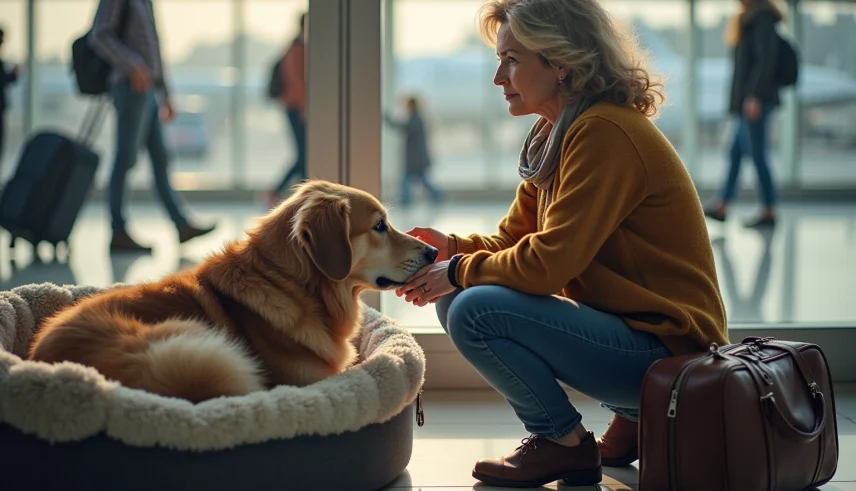
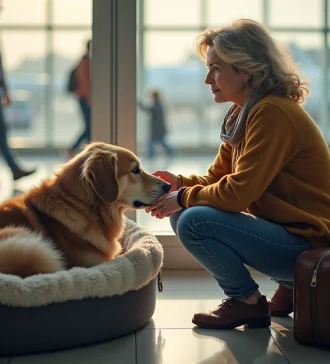
How to Fly with Large Dog in Cabin: Essential Steps for Travel
by Lena Park
Last updated: July 16, 2025
Verified and Approved by:
Angela Morris,
MSW, LCSW
Fact Checked

Overview
Traveling with a large dog in the cabin can be a daunting experience, and it’s important to understand the airline policies that often require purchasing an extra seat for larger pets. Additionally, gathering necessary documentation, such as a health certificate, is crucial. By checking specific airline regulations and preparing your dog for travel, you can alleviate some of the stress associated with flying. This preparation not only helps ensure a smoother experience but also helps you avoid potential issues at the airport, allowing you to focus on the joy of traveling together.
Introduction
Navigating air travel with a large dog can be a daunting task. Many airlines impose strict size restrictions on in-cabin pets, which can leave you feeling anxious and uncertain. However, as the landscape of pet travel evolves, opportunities are emerging for owners eager to bring their furry companions along for the journey.
What steps must you take to ensure a smooth and compliant experience? This guide delves into the essential policies, documentation, and strategies to make flying with a large dog not just possible, but enjoyable for both you and your beloved pet.
Understand Airline Policies for Large Dogs
Before reserving your flight, it’s important to understand the specific pet regulations of the airline, especially regarding how to fly with a large dog in cabin. Many carriers typically limit in-cabin travel to smaller animals weighing under 20 pounds, which can be disheartening for pet owners. However, there are options available. Some airlines, like Alaska Airlines and JSX, explain how to fly with a large dog in cabin if an extra seat is purchased. As we move into 2025, a positive shift is occurring, with more airlines recognizing the need to accommodate larger pets. For instance, Alaska Airlines permits passengers to bring up to two pets in the cabin, provided they pay for adjacent seats, while JSX offers flexible options for larger animals, requiring a seat purchase for those exceeding size restrictions.
It’s heartening to see that an increasing number of airlines are changing their policies to allow bigger pets in the cabin, reflecting a broader trend in the pet travel industry. To ensure a smooth experience when figuring out how to fly with a large dog in cabin, it’s essential to check the airline’s website or contact customer service directly to verify their current policies, as these can change frequently. Additionally, understanding how to fly with a large dog in cabin and familiarizing yourself with the airline’s requirements is crucial; often, the carrier must fit under the seat in front of you and be well-ventilated and leak-proof.
Moreover, be mindful of the costs associated with how to fly with a large dog in cabin, which may include fees for purchasing additional seats or cargo transport costs—typically ranging from $200 to $1,000+, depending on the size and destination. It’s also important to have a health certificate issued within 10 days of departure, as many airlines require this documentation. Understanding these policies will guide you on how to fly with a large dog in cabin, helping you avoid any last-minute surprises at the airport and ensuring a more seamless journey for both you and your beloved furry companion.
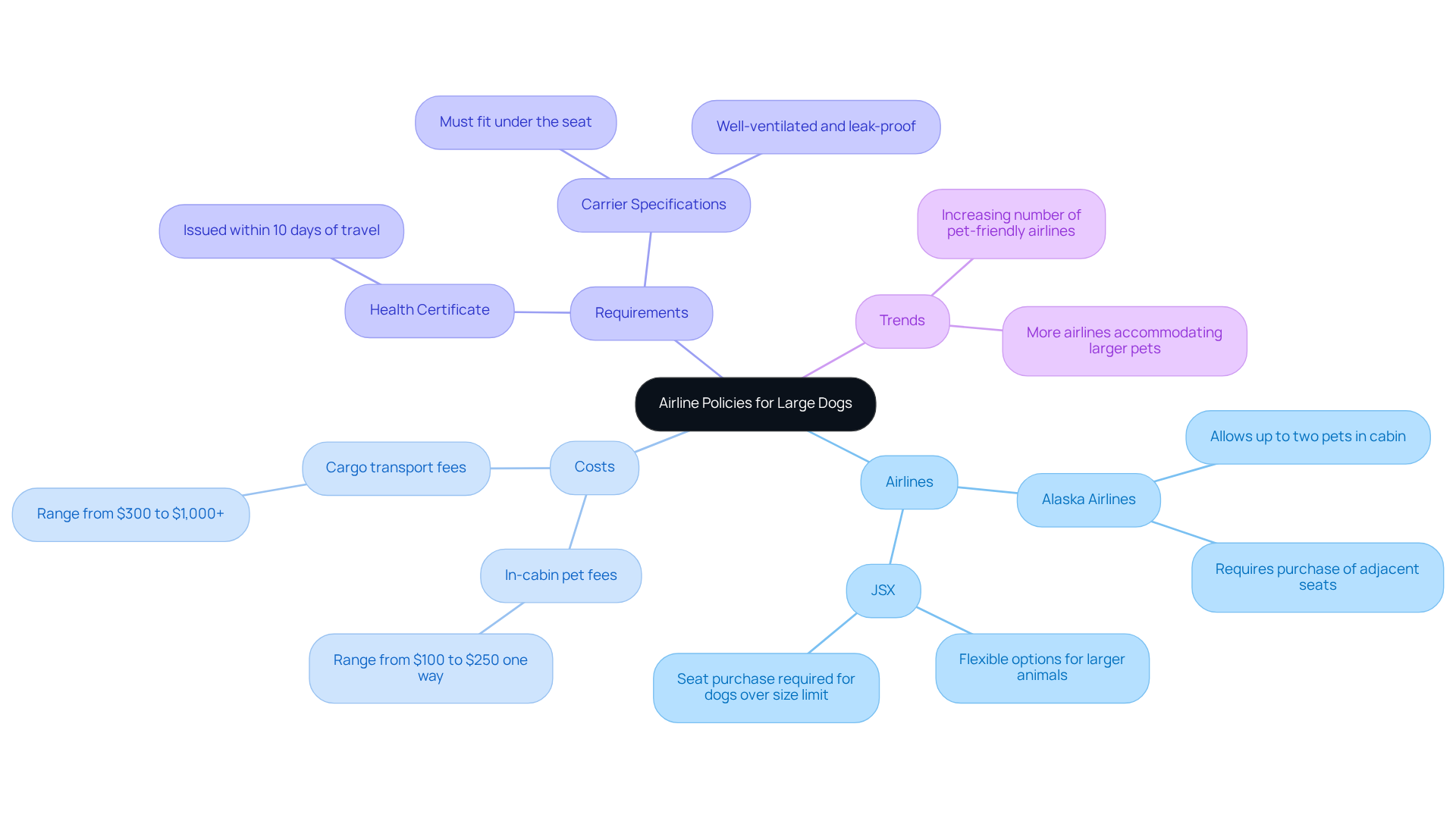
Prepare for Your Flight with Essential Documentation
To ensure a smooth journey, it’s important to understand how to fly with a large dog in cabin by gathering all necessary documentation well in advance of your flight. A health certificate issued by a licensed veterinarian within 10 days of departure is essential, confirming that your dog is healthy and fit to fly. This certificate often includes proof of vaccinations, particularly the rabies vaccine, which many airlines require.
It’s worth noting that Air Canada no longer recognizes emotional support animals, so if your dog serves as a psychiatric service dog, additional documentation verifying this status will be necessary. This includes:
- A U.S. DOT form
- A PSD letter from a licensed mental health professional
Keeping copies of all documents in your carry-on bag can ease your mind, allowing for easy access during check-in and boarding. Furthermore, it’s wise to check for any specific pet entry requirements at your destination, especially when traveling internationally, as regulations can vary significantly.
Having a well-prepared set of documents not only facilitates a smoother boarding process but also helps address any potential issues that may arise during your journey, particularly regarding how to fly with a large dog in cabin. Additionally, if you are traveling by plane, obtaining a Certificate of Veterinary Inspection (CVI) may be necessary.
Many clients, like Linda S. and James B., have shared their positive experiences with Wellness Wag, praising their exceptional service and quick approval process, which makes the application for ESA letters feel effortless and professional.
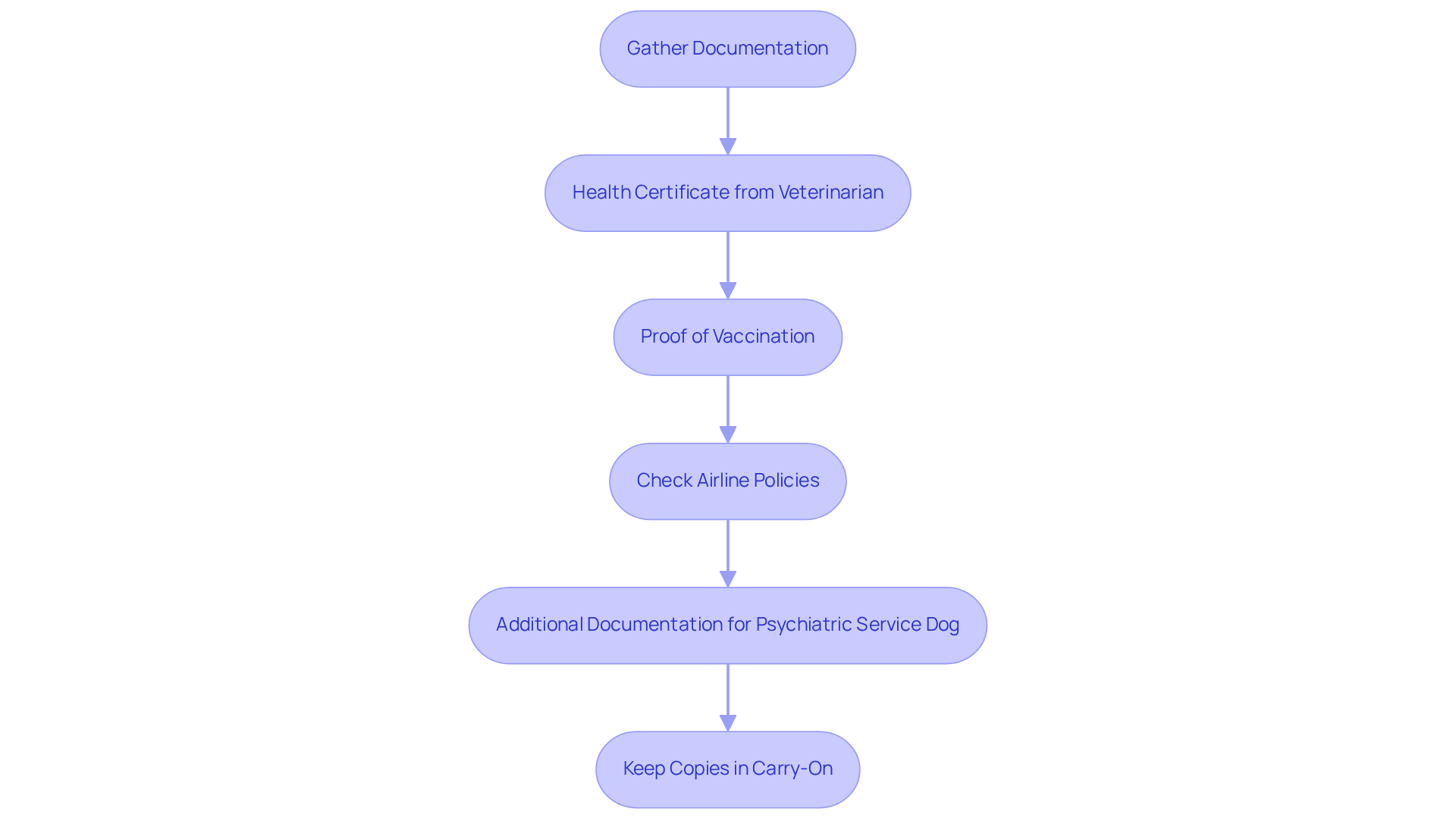
Manage the In-Flight Experience for Your Dog
To ensure a comfortable flight for your beloved dog, it’s essential to start acclimating them to their carrier well in advance, particularly when learning how to fly with large dog in cabin. Allow your dog to explore the carrier at home, and consider placing familiar items inside, such as a cozy blanket or a favorite toy, to foster a sense of security.
On departure day, arriving at the airport early will provide you with ample time for check-in and security procedures, reducing stress for both you and your pet. If your dog is an emotional support animal (ESA), understanding how to fly with large dog in cabin can be incredibly beneficial. This letter is crucial for understanding how to fly with large dog in cabin, allowing your pet to travel with you at no extra cost and providing emotional support throughout your journey.
During the flight, maintaining a calm atmosphere is vital. Speak softly to your dog and offer treats or toys to help distract them. If your dog tends to experience anxiety, it’s wise to consult your veterinarian about potential calming aids or medications that can assist during the journey. Research indicates that around 44.3% of dog owners report their pets experiencing a mental or emotional disorder while traveling, highlighting the importance of effective anxiety management.
Additionally, it’s crucial to note that approximately half of the 122 canine fatalities linked to airline journeys over the past five years involved short-faced breeds, which are particularly vulnerable during air transport. Remember to check on your dog periodically, ensuring they have access to water, especially on longer flights. Familiarizing your dog with their transport crate can significantly reduce anxiety, as many dogs may not fully understand the circumstances during takeoff and landing.
As a veterinarian emphasizes, “Acclimation of their crate is the most important thing.” By taking these compassionate steps, you can help ensure a smoother travel experience, especially when considering how to fly with large dog in cabin.
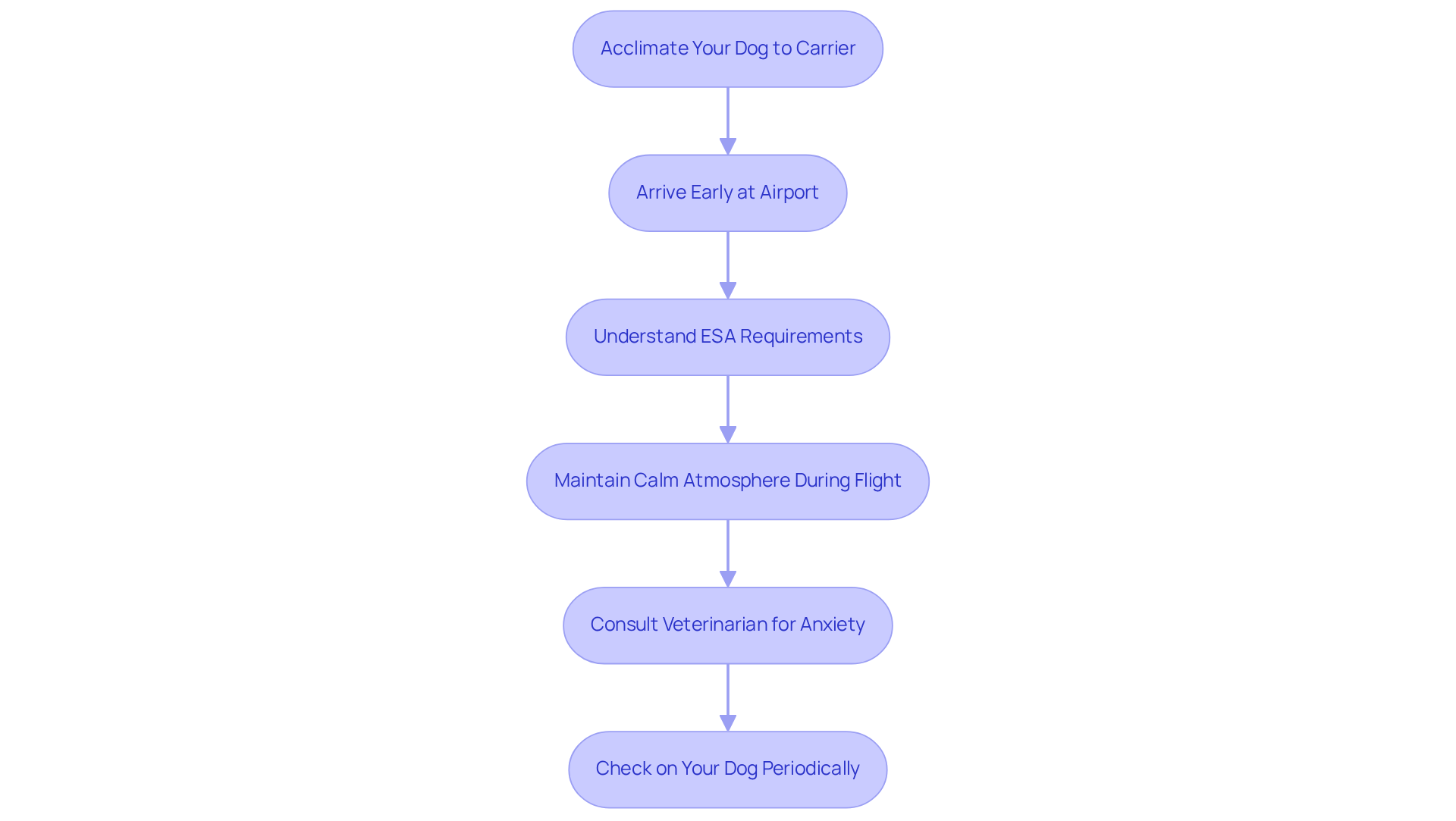
Conclusion
Understanding how to fly with a large dog in cabin is essential for ensuring a smooth and enjoyable travel experience for both pet and owner. As more airlines recognize the need to accommodate larger pets, staying informed about specific policies and requirements becomes crucial. This knowledge can significantly impact your journey and alleviate concerns.
Consider the emotional challenges you may face while traveling with your furry companion. Verifying airline regulations, preparing necessary documentation such as health certificates, and managing your dog’s in-flight experience can help minimize anxiety for both of you. Have you thought about familiarizing your dog with their carrier beforehand? Arriving early at the airport can also ease the travel process, allowing you to navigate any unexpected hurdles together.
Moreover, understanding the costs associated with flying with a large dog, including potential fees for additional seats, is vital for budget planning. This awareness can help you feel more prepared and less stressed about your financial commitments.
Ultimately, traveling with a large dog in cabin can be a rewarding experience when approached with the right preparation and knowledge. By taking the time to research, prepare, and implement strategies for a comfortable journey, you can ensure that your furry companion enjoys the adventure just as much as you do. Embrace this opportunity to create lasting memories with your beloved pet by making informed decisions and prioritizing their well-being throughout the travel process.
Frequently Asked Questions
What should I know about airline policies for flying with large dogs?
It’s important to understand that many airlines limit in-cabin travel to smaller pets under 20 pounds. However, some airlines, like Alaska Airlines and JSX, allow larger dogs to fly in the cabin if an extra seat is purchased.
Which airlines allow large dogs to fly in the cabin?
Alaska Airlines permits passengers to bring up to two pets in the cabin with adjacent seat purchases, while JSX offers flexible options for larger animals, requiring a seat purchase for those exceeding size restrictions.
Are airline policies for large dogs changing?
Yes, more airlines are beginning to accommodate larger pets in the cabin, reflecting a positive trend in the pet travel industry.
How can I find out the specific pet policies of an airline?
It’s essential to check the airline’s website or contact their customer service directly to verify current policies, as they can change frequently.
What are the requirements for flying with a large dog in the cabin?
The carrier must fit under the seat in front of you and be well-ventilated and leak-proof. Additionally, a health certificate issued within 10 days of departure is often required.
What costs should I expect when flying with a large dog in the cabin?
Costs may include fees for purchasing additional seats or cargo transport, typically ranging from $200 to $1,000+, depending on the size of the dog and the destination.
How can I ensure a smooth experience when flying with my large dog?
Familiarize yourself with the airline’s requirements and policies, and ensure you have all necessary documentation to avoid last-minute surprises at the airport.
Certify Your Emotional Support Animal Today

Why You Can Rely on Us?
At Wellness Wag, we believe your pet deserves care rooted in both science and compassion. Each article is carefully researched, written in clear language for pet owners, and then reviewed by qualified professionals to ensure the information is evidence-based, current, and practical for real-life care. Our goal is to help you feel confident in making informed decisions about your pet’s health and well-being.
Reviewed by
Angela Morris, MSW, LCSW
Angela is a licensed clinical social worker with 20 years of experience in patient advocacy and community mental health. She has assisted numerous clients with ESA evaluations and brings a deep understanding of disability accommodations, ensuring that all information is accurate, supportive, and practical.

Written by :
Lena Park
Last Updated :
July 16, 2025












